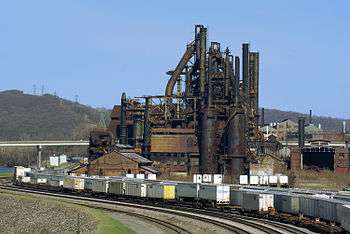History of the steel industry (1970–present)
The global steel industry has been going through major changes since 1970. China has emerged as a major producer and consumer, as has India to a lesser extent. Consolidation has been rapid in Europe.
Growth of the industry
Global steel production grew enormously in the 20th century from a mere 28 million tonnes at the beginning of the century to 781 million tons at the end.[1] Per-capita steel consumption in the US peaked in 1977, then fell by half before staging a modest recovery to levels well below the peak.[2]
World steel production in the 20th century

Production of crude steel has risen at an astounding rate, reaching 1,691 m tonnes by 2017
During the 20th century, the consumption of steel increased at an average annual rate of 3.3%. In 1900, the United States was producing 37% of the world's steel, but With post war industrial development in Asia and centralised investment by China, by 2017 China alone accounted for 50%, with Europe (including the former Soviet Union) down to 24% and North America down to 6%.
For details of country-wise steel production see steel production by country.
Growth potential of the industry
Amongst the other newly steel-producing countries, in 2017 South Korea produces 71 million tonnes, nearly double Germany; and Brazil 34 million tonnes; all three countries little changed since 2011. Indian production in 2017 production is just over 100 million tonnes; up substantially from 70 in 2011 – compared to only 1 million tonnes at the time of its independence in 1947. By 1991, when the economy was opened up steel production grew to around 14 million tonnes. Thereafter, it doubled in the next 10 years, and then it is doubling again, maybe over a slightly longer span.
The world steel industry flattened from 2007–2009 at 1,300 million tonnes, before rising again, due to worldwide recession starting in 2008, with its heavy cutbacks in construction, sharply lowered demand and prices falling 40%. Showing the impact of that plateau, in 2007 ThyssenKrupp spent $12 billion to build the two most modern mills in the world, situated in Alabama and Brazil. They lost $11 billion on the new plants, which sold steel below the cost of production. Finally in 2013, the plants were sold at under $4 billion.
Reduction in workforce
A modern steel plant employs very few people per tonne, compared to the past. In South Korea, Posco employs 29,648 people to produce 28 million tonnes.
During the period 1974 to 1999, the steel industry had drastically reduced employment all around the world. In USA, it was down from 521,000 to 153,000. In Japan, from 459,000 to 208,000; Germany from 232,000 to 78,000; UK from 197,000 to 31,000; Brazil from 118,000 to 59,000; South Africa from 100,000 to 54,000. South Korea already had a low figure. It was only 58,000 in 1999. The steel industry had reduced its employment around the world by more than 1,500,000 in 25 years.
See also
- American Iron and Steel Institute
- British Steel Corporation
- Dominion Steel and Coal Corporation, in Canada
- European Coal and Steel Community
- Iron and steel industry in India
- Iron and steel industry in the United States
- Steel production by country
- Steel industry in China
- Steelmaking
References
- International Iron and Steel Institute 2006 report
- Development, O. f.-o. (9 July 2009). OECD Steel Committee - Presentation for the Council Working Party on ShipBuilding. Retrieved from www.oecd.org/stiu/ind/43312347.pdf
- Editors, T. (31 May 2011). Iron & Steel. Retrieved from Market Size Blog: www.marketsize.com/blog/index.php/2011/05/31/iron-steel
- EEF. (6 June 2008). Analysis of steel price developments - summer 2008. Retrieved from www2.eef.org.uk: www2.eef.org.uk
- O'Hara, M. (28 November 2014). U.S. Steel takes steps in transformation. Retrieved from Market Realist: http://marketrealist.com/2014/11/insight-u-s-steels-transformation/
- Smith, J. L. (6 November 2009). The 2008 Oil Price Shock: Markets or Mayhem? Retrieved from Resources for the Future: http://www.rff.org/Publications/WPC/Pages/The-2008-Oil-Price-Shock-Markets-or-Mayhem.aspx
- Tang, R. (21 September 2010). China's Steel Industry and Its Impact on the United States:Issues for Congress. Retrieved from Congressional Research Service: https://fpc.state.gov/documents/organization/150173.pdf
- The Economist. (13 October 2012). Iron Ore - The lore of ore. Retrieved from The Economist: http://www.economist.com/node/21564559
- Boundless. "Politics and the Great Recession of 2008." Boundless Political Science. Boundless, 3 July 2014. Retrieved 13 Dec. 2014 from https://www.boundless.com/political-science/textbooks/boundless-political-science-textbook/economic-policy-16/politics-and-economic-policy-104/politics-and-the-great-recession-of-2008-556-5848/
Appendices
Both appendices are from IISI material, earlier on the web but now replaced by more recent data.
- Appendix 1
- Smil, Vaclav (2006). Transforming the Twentieth Century: Technical Innovations and Their Consequences. Oxford, New York: Oxford University Press.
Further reading
- Bagchi, Jayanta. Development of Steel Industry in India (2005)
- Ball, Jeffrey A. U.S. Manufacturing Dogfights: China's Steel and Foreign Aircraft Competition (2011)
- D'Costa, Anthony P. The Global Restructuring of the Steel Industry: Innovations, Institutions, and Industrial Change London: Routledge, 1999 online version
- Etienne, Gilbert. Asian Crucible: The Steel Industry in China and India (1992) *Hasegawa, Harukiyu. The Steel Industry in Japan: A Comparison with Britain 1996 online version
- Hoerr, John P. And the Wolf Finally Came: The Decline of the American Steel Industry (1988) excerpt and text search
- Hogan, Thomas. The Steel Industry of China: Its Present Status and Future Potential (1999)
- Hogan, William T. Minimills and Integrated Mills: A Comparison of Steelmaking in the United States (1987)
- Meny, Yves. Politics of Steel: Western Europe and the Steel Industry in the Crisis Years (1974–1984) (1986)
- Scheuerman, William. The Steel Crisis: The Economics and Politics of a Declining Industry (1986) online